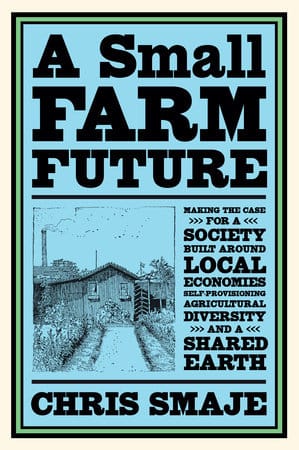A Small Farm Future
Making the Case for a Society Built Around Local Economies, Self-Provisioning, Agricultural Diversity and a Shared Earth

EXCERPTS
| Pages: | 320 pages |
| Size: | 6 x 9 inch |
| Publisher: | Chelsea Green Publishing UK |
| Pub. Date: | September 29, 2020 |
| ISBN: | 9781603589024 |
A Small Farm Future
Making the Case for a Society Built Around Local Economies, Self-Provisioning, Agricultural Diversity and a Shared Earth
Paperback
$24.95
A modern classic of the new agrarianism
“Chris Smaje…shows that the choice is clear. Either we have a small farm future, or we face collapse and extinction.”—Vandana Shiva
“Every young person should read this book.”—Richard Heinberg
In a groundbreaking debut, farmer and social scientist Chris Smaje argues that organizing society around small-scale farming offers the soundest, sanest and most reasonable response to climate change and other crises of civilisation—and will yield humanity’s best chance at survival.
Drawing on a vast range of sources from across a multitude of disciplines, A Small Farm Future analyses the complex forces that make societal change inevitable; explains how low-carbon, locally self-reliant agrarian communities can empower us to successfully confront these changes head on; and explores the pathways for delivering this vision politically.
Challenging both conventional wisdom and utopian blueprints, A Small Farm Future offers rigorous original analysis of wicked problems and hidden opportunities in a way that illuminates the path toward functional local economies, effective self-provisioning, agricultural diversity and a shared earth.
Perfect for readers of both Wendell Berry and Thomas Piketty, A Small Farm Future is a refreshing, new outlook on a way forward for society—and a vital resource for activists, students, policy makers, and anyone looking to enact change.
Reviews & Praise
“We are facing an existential crisis – with species extinction, climate catastrophes, desertification of soil, disappearance of water, pandemics of infectious and chronic diseases, hunger and malnutrition. Industrialized, globalized agriculture based on the myth that it feeds the world is driving the multiple, interconnected crisis. Eighty percent of the food we eat comes from small farms. Chris Smaje’s A Small Farm Future shows that the choice is clear. Either we have a small farm future, or we face collapse and extinction.”—Vandana Shiva, author of Oneness vs. the 1% and Who Really Feeds the World?
“A Small Farm Future is a solid and truly inspiring book. I have dedicated the last 17 years of my life to creating a micro farm, and what I have learned fully confirms what Chris Smaje says: a small, ecologically inspired farm can produce high-quality, local food while also improving soil fertility, storing carbon, conserving water resources and improving biodiversity. Not to mention creating jobs and improving quality of life. A return to Mother Earth is the foundation on which we can build a new paradigm of sustainable and equitable abundance based on biological resources, renewable energies, eco-construction and solidarity – among individuals and cultures, and across generations. Getting out of a virtual and globalized economy to cultivate the land with love and respect is our only hope to pass on a viable planet to our children. This is also the secret to happiness!”—Charles Hervé-Gruyer, author of Miraculous Abundance; co-founder, Bec Hellouin Farm, France
“On one side we have science-based high tech with neoliberal economics, driven by the perceived need to control nature and to maximize material wealth; and on the other are traditional human skills and values. Whether it’s dressed in the trappings of communism or capitalism or autocracy or democracy, the former is undoubtedly winning. Governments and their chosen advisers the world over equate high tech and measurable economic ‘growth’ with progress.
But the dominance of what now passes as modernity is killing us all. The methods it gives rise to and the mindset behind it are at the root of all the world’s crises. What we need now above all else is food production based on small farming – albeit assisted by excellent science and sometimes by high tech; feeding into localised economies; and deployed with true concern for the welfare of humanity and our fellow creatures. Chris Smaje, a sociologist-cum-anthropologist turned smallholder, is showing us exactly what is needed and why. A timely and valuable book – and a very readable read.”—Colin Tudge, co-founder, Oxford Real Farming Conference and the College for Real Farming and Food Culture; author of The Great Re-Think
“A Small Farm Future makes plain that the next 30 years will look very different to the last 30. Yet Smaje’s unique integration of big-picture insight and hard-won experience clears the fog, brilliantly revealing reliable and meaningful paths forward, even as the ground shifts beneath our feet.”—Shaun Chamberlin, author of The Transition Timeline; editor of Lean Logic and Surviving the Future
“This book is such a treat. In an era of generalized crisis, Chris Smaje articulates an appealing, beautiful vision of the future. Chris has walked the talk, which makes his plea all the more powerful and convincing.”—Dr. Giorgos Kallis, ICREA research professor, Universitat Autònoma de Barcelona (UAB)
“Anyone involved in political thought, agriculture, justice, or futurism who is not familiar with Chris Smaje’s writing from his blog should do themselves the favor of picking up this book as soon as possible. Smaje’s writing is pretty much always worth engaging with – whether for the wry humor, the ways he challenges us to think harder and more boldly, his relentless humanism or his ability to marry nuance with accessibility. He is a visionary in the most interesting and exciting meaning of the word. His writing consistently shows him to be an intellectual tour guide par excellence: he may or may not see further than others, but he certainly never fails to help us see what is in front of us better.”—M. Jahi Chappell, executive director, Southeastern African-American Farmers’ Organic Network (SAAFON); author of Beginning to End Hunger
“Chris Smaje brings intellectual rigour to the centuries-old demand for ‘three acres and a cow’.”—Simon Fairlie, author of Meat: A Benign Extravagance; editor, The Land magazine
“Superb! This book shows with great clarity why we are heading for planetary disaster and suggests ways in which new kinds of more stable social and economic practices might evolve around support for sustainable agriculture. A timely and compelling vision of a New Agrarianism. Highly recommended.”—Paul Richards, author of Indigenous Agricultural Revolution and Ebola; emeritus professor of technology and agrarian development, Wageningen University
“Time to tune in – these are powerful arguments for collective action in agriculture. We know that small farms offer solutions to the crises of our time. Stewardship, guardianship and rebuilding biodiversity is real, meaningful work. If each human engaged meaningfully, every day, in their own subsistence, imagine how much more accountable our society would become. This restoration of our food and ecosystems will take many hands, many years, and much patience and goodwill. This means that those of us already farming will need to become well versed in transmitting the why and the how to those who will join us. The coming radical shifts in ownership, tenure, settlement and structure present an incredible opportunity for sanity, subsistence and self-determination. Onward!”—Severine von Tscharner Fleming, director, Greenhorns; chair, Agrarian Trust
“As a breakdown of the climate, state power and globalized markets pushes us toward an epochal transition, Chris Smaje offers us a hopeful vision of a relocalized, self-sufficient world. With fierce intelligence and rich evidence, he explains the vital role that small farms must play in this emerging future, artfully weaving together neglected strands of economic, ecological, cultural and political thought.”—David Bollier, director, Reinventing the Commons Program, Schumacher Center for a New Economics; coauthor (with Silke Helfrich) of Free, Fair and Alive: The Insurgent Power of the Commons







